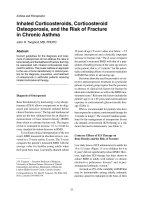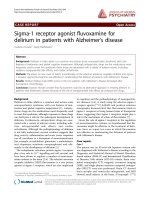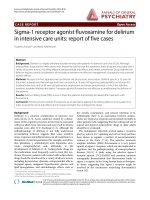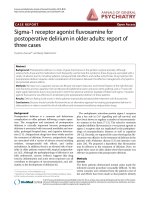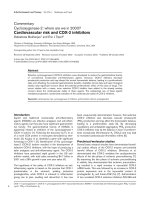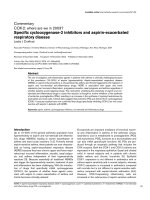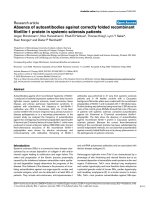Báo cáo y học: "Inhaled steroid/long-acting β2 agonist combination products provide 24 hours improvement in lung function in adult asthmatic patients" pps
Bạn đang xem bản rút gọn của tài liệu. Xem và tải ngay bản đầy đủ của tài liệu tại đây (288.41 KB, 8 trang )
BioMed Central
Page 1 of 8
(page number not for citation purposes)
Respiratory Research
Open Access
Research
Inhaled steroid/long-acting β2 agonist combination products
provide 24 hours improvement in lung function in adult asthmatic
patients
Jan Lötvall
1
, Stephen Langley
2,4
and Ashley Woodcock*
3
Address:
1
Department of Internal Medicine/Respiratory Medicine and Allergology, Sahlgrenska Academy, Göteborg University, Sweden,
2
Medicines Evaluation Unit, North West Lung Centre, Wythenshawe Hospital, Manchester, UK,
3
University of Manchester, Manchester, UK and
4
Deceased
Email: Jan Lötvall - ; Stephen Langley - ;
Ashley Woodcock* -
* Corresponding author
Abstract
Background: The combination of inhaled corticosteroids (ICS) and long-acting β2-agonists
(LABA) is recommended by treatment guidelines for the treatment of persistent asthma. Two such
combination products, salmeterol/fluticasone propionate (SFC, Seretide™ GSK, UK) and
formoterol/budesonide (FBC, Symbicort™, AstraZeneca, UK) are commercially available.
Objectives: The purpose of these studies was to evaluate and compare the duration of
bronchodilation of both combination products up to 24 hours after a single dose.
Methods: Two randomised, double blind, placebo-controlled, crossover studies were performed.
Study A was conducted in 33 asthmatic adults receiving 400–1200 mcg of budesonide or equivalent.
Serial forced expiratory volume in one second (FEV
1
) was measured over 24 hours to determine
the duration of effect of both SFC (50/100 mcg) and FBC (4.5/160 mcg). Study B was conducted in
75 asthmatic adults receiving 800–1200 mcg of budesonide or equivalent and comprised a 4 week
run-in of 400 mcg bd Becotide™ followed by 4 weeks treatment with either SFC 50/100 mcg bd
or FBC 4.5/160 mcg bd taken in a cross-over manner. Serial 24-hour FEV
1
was measured after the
first dose and the last dose after each 4-weeks treatment period to determine the offset of action
of each treatment.
Results: In study A, a single inhalation of SFC and FBC produced a sustained bronchodilation at
16 hours with an adjusted mean increase in FEV
1
from pre-dose of 0.22 L (95% CI 0.19, 0.35 L) for
SFC and 0.25 L (95% CI 0.21, 0.37 L) for FBC, which was significantly greater than placebo for both
treatments (-0.05 L; p < 0.001). In study B, the slope of decline in FEV
1
from 2–24 hours post dose
was -16.0 ml/hr for SFC and -14.2 ml/hr for FBC. The weighted mean AUC over 24 hours was 0.21
Lxmin and 0.22 Lxmin and mean change from pre-dose FEV
1
at 12 hours was 0.21 L for SFC and
0.20 L for FBC respectively
Conclusion: Both SFC and FBC produced a similar sustained bronchodilator effect which was
prolonged beyond 12 hours post dose and was clearly measurable at 24 h.
Published: 18 August 2006
Respiratory Research 2006, 7:110 doi:10.1186/1465-9921-7-110
Received: 29 December 2005
Accepted: 18 August 2006
This article is available from: />© 2006 Lötvall et al; licensee BioMed Central Ltd.
This is an Open Access article distributed under the terms of the Creative Commons Attribution License ( />),
which permits unrestricted use, distribution, and reproduction in any medium, provided the original work is properly cited.
Respiratory Research 2006, 7:110 />Page 2 of 8
(page number not for citation purposes)
Background
The benefit of adding a long-acting β2-agonist (LABA) to
inhaled corticosteroid therapy (ICS) in the treatment of
asthma is well-established [1-3]. Two such combinations,
salmeterol xinafoate and fluticasone propionate (SFC,
Seretide™) and formoterol and budesonide (FBC, Symbi-
cort™) are widely used and have been shown to be effec-
tive in controlling asthma of varying severity in adults and
children [4-8]. A limited number of studies have com-
pared these two combination products [9,10], and the
data imply some different clinical profiles due to the dif-
ferent pharmacological properties of the ICS and LABAs
[9,11-13].
When taken on a regular basis, both SFC and FBC have
shown clinical efficacy compared to placebo in patients
with mild to moderate asthma [14,15]. We therefore
aimed to evaluate and compare the bronchodilator
response of SFC and FBC over a 24-hour period after sin-
gle or repeated dosing. In addition, we asked whether tol-
erance to the bronchodilating effect of either treatment
develops after regular twice-daily dosing for four weeks.
This paper describes the combined results of two studies
designed to meet these objectives.
Subjects and methods
Study design
This data represents a combination of two studies. Study
A was a single centre, double blind, randomised, single-
dose, placebo-controlled, 3-way crossover study con-
ducted in Sweden. Study B was performed at three centres
in the UK and was a double blind, randomised, 2-way, 4-
week crossover study. Both studies were conducted in
accordance with the Declaration of Helsinki and were
subject to Ethics Committee approval prior to commence-
ment. Written informed consent was obtained from each
patient prior to the initiation of any study-related proce-
dures.
Study population
Both studies
Adults aged ≥ 18 years with a documented clinical diagno-
sis of asthma for at least 6 months prior to the study were
eligible for entry. Subjects were required to have a pre-
bronchodilator FEV
1
of >50% predicted normal and dem-
onstrate an increase from baseline in FEV
1
of at least 15%
of the predicted value 15 minutes after administration of
400 mcg of salbutamol. Subjects who were pregnant or
had a smoking history of ≥ 10 pack years, were excluded.
In addition, to ensure that subjects had stable disease, any
subject who had an acute asthma exacerbation requiring
either oral steroid treatment or hospital treatment, a respi-
ratory tract infection or a change in regular asthma medi-
cation within the preceding 4 weeks were excluded from
both studies.
Study A
Subjects were required to be receiving 400–1200 mcg of
budesonide or equivalent for at least 4 weeks prior to the
study. Subjects who had received oral β2-agonists, slow
release bronchodilators, anti-leukotrienes, sodium cro-
moglycate or nedocromil sodium within the preceding
two weeks were excluded. Subjects were also required to
stop taking long acting β2-agonists 2 weeks prior to visit 1.
Study B
Subjects were required to be receiving between 800–1200
mcg of budesonide or BDP or 400–600 mcg/day of FP or
QVAR for at least 4 weeks prior to the study. Subjects who
had received anti-leukotrienes, theophyllines or oral,
depot or parenteral corticosteroids within 4 weeks prior to
visit 1 were excluded.
Study treatment
Study A
Subjects were randomised to receive a single dose of SFC
50/100 mcg or FBC 4.5/160 mcg or placebo which was
administered in the Clinic. This dose of FBC is the actu-
ated dose from a 6.0/200 mcg inhaler.
Medication was administered as one inhalation from a
Diskus inhaler containing either SFC or placebo followed
by one inhalation from a breath actuated device contain-
ing either FBC or placebo according to their blinded ran-
domisation order generated. Inhalation from the Diskus
was first so that the onset of action of formoterol could
not be unblinded. Subjects attended the Clinic for three
24-hour intensive study days with a washout period of 3–
7 days between study days. Subjects took their usual per-
mitted asthma medication between study days and salb-
utamol was provided for relief medication.
Study B
All subjects received open label Becotide™ 400 mcg twice
daily during a 4 week run-in. Subjects were subsequently
randomised to receive 4 weeks treatment with either SFC
50/100 mcg twice daily administered from a Diskus
inhaler or FBC 4.5/160 mcg twice daily from a breath
actuated device. This dose of FBC is the actuated dose
from a 6.0/200 mcg inhaler.
Becotide 400 mcg twice daily was given for 4-weeks dur-
ing the washout period and subjects then crossed over to
receive the active medication that they did not receive dur-
ing the first 4-week period for a further 4-weeks. Subjects
attended the Clinic for four 24-hour intensive study days
on day 1 and day 28 of each treatment period. Salbutamol
was provided for relief medication.
Respiratory Research 2006, 7:110 />Page 3 of 8
(page number not for citation purposes)
Outcome measures
In study A, FEV
1
was measured pre-dose (Time 0), and
then 0.5, 1, 2, 4, 6, 8, 10, 12, 14, 16, 20 and 24 hours fol-
lowing a single morning dose of study medication. An ear-
lier time point was not chosen as this has already been
assessed in a previous study [9]. Measurements were made
using a Vitalograph Spirometer, which was calibrated reg-
ularly.
In study B, FEV
1
was measured pre-dose and at 0.5, 1, 2, 4,
6, 8, 10, 12, 14, 16, 20 and 24 hours following a single
morning dose of study medication using a KoKo™ spirom-
eter. Subjects were given a mini-Wright™ peak flow meter
(Clement Clark, UK) to measure the highest of three
morning and evening peak expiratory flow (PEF) meas-
urements during the run-in, treatment and washout peri-
ods. Where possible, peak flow measurements were
performed at the same time of day prior to study drug or
use of relief salbutamol.
Safety was assessed by monitoring adverse events.
Statistical analysis
In study A, the primary assessment of efficacy was the
mean change from pre-dose FEV
1
(on each study day) to
16 hours post-dose. Sixteen hours was chosen as subjects
commonly have 16 hours between twice daily dose
regimes. In order to detect a difference of 180 mL between
the treatments, at a two-sided α = 0.05 significance level
with 80% power, 32 subjects were required to complete
all the treatment periods. Analysis of covariance appropri-
ate for cross-over study designs which included terms for
subject, treatment and period was used to estimate the
treatment difference and p-value and to calculate the 95%
confidence interval for this difference.
In study B, the primary efficacy endpoints were the slope
of decline in FEV
1
from 2 hours post-dose, the area under
the FEV
1
curve (AUC) (0–24 hours) and the mean change
from pre-dose FEV
1
at 12 hours post dose. Secondary end-
points were based on serial FEV
1
measurements after a sin-
gle dose after 4 weeks of treatment (as for the primary
endpoint). The sample size was determined on the basis
of anticipated differences between treatments in the mean
change from pre-dose FEV
1
at 12 hours, which was
thought to be the least sensitive of all three endpoints. In
order to detect a difference of 180 mL between the treat-
ments, at a two-sided α = 0.05 significance level with 90%
power, 58 subjects were required to complete both treat-
ment periods. The slope coefficient was analysed using
analysis of covariance, which included terms for subject,
treatment, period and baseline, and was used to estimate
the treatment difference and p-value and to calculate the
95% confidence interval for this difference. The AUC FEV
1
and mean change from pre-dose FEV
1
at 12 hours post-
dose were also analysed using ANCOVA.
Lung function endpoints calculated from the DRC were
analysed using analysis of covariance, allowing for effects
due to subject, centre, treatment and period.
Results
Demography
A total of 33 subjects were recruited into study A of whom
all were randomised and received all three study medica-
tions. A total of 206 subjects were recruited into study B of
which 75 were randomised, 67 subjects received both SFC
and FBC. Of the 131 patients withdrawn prior to ran-
domisation, 118 did not fulfill the entry criteria. There
were nine withdrawals post-randomisation in study B, of
which seven were due to adverse events. The baseline
characteristics of subjects in both studies, including dose
of inhaled corticosteroid are shown in Table 1.
Primary endpoints
Study A
Both SFC and FBC increased FEV
1
at 16 hours post dose to
a similar extent. The improvement from pre-dose baseline
was 0.22 L for SFC and 0.25 L for FBC, which was statisti-
cally significant compared with placebo for both treat-
ments (-0.05 L; p < 0.001) (Table 2).
Study B
For the three primary endpoints of mean change from pre-
dose FEV
1
at 12 hours, area under the FEV
1
curve
(weighted mean) over 24 hours, and slope of decline from
2 hours post-dose to 24 hours, both SFC and FBC resulted
in a sustained bronchodilation > 12 hours with no statis-
tical difference between the treatments (Table 3).
Secondary endpoints
Study A
The mean change in FEV
1
from pre-dose baseline was
measured for 24 hours following administration of a sin-
gle inhalation of study medication (Figure 1). At each
evaluated time point, the mean change in both the SFC
and FBC group was statistically significant compared with
placebo and was similar for the two active treatments with
no statistical difference between them at any time point
(Table 4).
Study B
Baseline mean FEV
1
increased after 4 weeks treatment
from 2.75 L to 2.87 L for SFC and from 2.78 L to 2.88 L
for FBC. After 4 weeks regular treatment, the increase in
FEV
1
from pre-dose over 24 hours was similar to the val-
ues measured before 4 weeks treatment with a sustained
bronchodilation > 12 hours and no statistical difference
between the treatments (Figures 2 and 3). The adjusted
Respiratory Research 2006, 7:110 />Page 4 of 8
(page number not for citation purposes)
mean change from pre-dose baseline in peak FEV
1
from
30 minutes to 24 hours post dose was 0.48 L and 0.53 L
for SFC and FBC prior to 4-weeks treatment (treatment
difference SFC-FBC -0.05 L; 95% CI -0.14, 0.04 L) and
0.32 L and 0.37 L after 4-weeks treatment (treatment dif-
ference SFC-FBC -0.05 L; 95% CI -0.11, 0.01 L).
For diary card parameters, the adjusted mean change from
baseline in morning PEF was 25 L/min in both the SFC
and FBC groups. In addition, the median number of days
with no use of relief medication was 63% in the SFC
group and 61% in the FBC group and the median number
of nights with no use of relief medication was also similar
with 93% in the SFC group compared to 89% in the FBC
group. There was no statistical difference between the
groups regarding any of these parameters.
Safety
There were no adverse events reported in study A. In study
B, 32 subjects in each group experienced an adverse event
during treatment of which headache was the most com-
mon reported by 9 subjects receiving SFC (12%) and 13
subjects receiving FBC (19%). There were no serious
adverse events.
Discussion
A single inhalation of SFC 50/100 mcg or FBC 4.5/160
mcg resulted in a similar, prolonged duration of bron-
chodilation over 24 hours which was statistically signifi-
cant when compared with placebo over the whole 24 h
observation period. A comparison of FEV
1
before and after
four weeks dosing with either SFC 50/100 mcg or FBC 4.5/
160 mcg twice daily was of a similar duration for each
treatment with a small reduction in magnitude, demon-
strating a lack of development of clinically important tol-
erance of the bronchodilating activity with regular
administration.
Before starting these studies, we hypothesised that the
pharmacological differences of the long-acting β2-agonist
component of the two combination products could result
in a different duration of effect over a 24-hour treatment
period [16,17]. Thus, in vitro it has been shown that salm-
eterol has a longer duration of effect than formoterol, but
Table 2: FEV
1
(L) at 16 hours post-dose after a single inhalation of either SFC (50/100 mcg), FBC (4.5/160 mcg) or placebo (Study A).
Placebo (n = 33) SFC (n = 33) FBC (n = 33)
Baseline adjusted mean (se) 2.74 (0.04) 3.01 (0.04) 3.03 (0.04)
Adjusted mean change at 16 hours from baseline (se) -0.05 (0.04) 0.22 (0.04) 0.25 (0.04)
SFC vs placebo FBC vs placebo
Statistical difference (se) 0.27 (0.04) 0.29 (0.04)
95% CI 0.19, 0.35 0.21, 0.37
P value <0.001 <0.001
SFC vs FBC
Statistical difference (se) -0.02 (0.04)
95% CI -0.10, 0.06
P value 0.617
Table 1: Patient Demography
Characteristic Study A Study B
Number of subjects screened 33 206
Number of subjects randomised 33 75*
Mean age (years) (sd) 40.2 (14.3) 36.4 (12.5)
Sex: Males/females % 48/52 48/52
Mean % predicted FEV
1
(sd) 80.5 (12.4) 82.8 (17.0)
Mean % reversibility (sd) 18.9 (6.9) 28.7 (17.6)
Duration of asthma (n):
< 5 years 25
10–20 years 931
>20 years 22 39
Current smoker, n (%) 1 (3%) 12 (16%)
Dose of ICS at screening for randomised patients (n)
BDP: 200 mcg bd/400 mcg bd/500 mcg bd 2/1/0 5/23/15
Budesonide: 200 mcg bd/300 mcg bd/400 mcg bd/600 mcg bd 10/1/13/0 0/0/21/1
FP: 100 mcg/250 mcg bd 2/4 2/8
* the majority of screen failures demonstrated insufficient bronchodilator reversibility
Respiratory Research 2006, 7:110 />Page 5 of 8
(page number not for citation purposes)
in clinical studies the duration is the same over 24 hours
of monitoring. Therefore, it is important to evaluate the
true offset of effect of these drugs beyond the 12 hour time
point. A number of studies have shown that both salme-
terol and formoterol have a long-lasting clinical efficacy
after a single daily dose, which maintains significance
above baseline at a 12 hour monitoring time point
[12,13,18-25]. In the current study (study A), both SFC
and FBC produced a similar prolonged bronchodilation
beyond 12 hours which was statistically and clinically sig-
nificant compared with placebo at 16 hours. This is
important as subjects may frequently have an interval of
up to 16 hours or more between doses which is why 16
hours was chosen as the primary time point for compari-
son in this study. The peak increase in FEV
1
between the
two drugs was also similar with the peak effect at 5.6
hours following a single inhalation of both SFC 50/100
mcg and FBC 4.5/160 mcg. Although the difference
between both drugs and placebo was statistically signifi-
cant throughout the 24 hour measurement period, it is
unlikely that the difference at the 24 hour point is clini-
cally significant as the lung function values after either
treatment approached their respective baseline values.
Formoterol has been shown to have a faster onset of
action than salmeterol during the first two hours after
inhalation [12,13,24]. FBC also has a faster onset of
action than SFC with a significant difference in the per-
centage increase in FEV
1
at 3 minutes post FBC dose com-
pared to a single inhalation of SFC [9]. The difference in
early improvement in lung function is however not signif-
icant at later time points, which indicates that the differ-
ence in bronchodilation between the two combinations
diminishes with time. FBC has also been demonstrated to
Mean FEV
1
vs time over 24 hours after single inhalation of SFC (50/100 mcg), FBC 4.5/160 mcg or placebo (study A)Figure 1
Mean FEV
1
vs time over 24 hours after single inhalation of SFC (50/100 mcg), FBC 4.5/160 mcg or placebo (study A).
-0.2
-0.1
0
0.1
0.2
0.3
0.4
0.5
0 0.51 2 4 6 8 101214162024
Time (hours)
Change from pre-dose FEV1 (L)
Placebo
SFC
FBC
Table 3: Analysis of primary endpoints (Study B) prior to 4-weeks regular treatment with SFC (50/100 mcg) or FBC (4.5/160 mcg)
SFC (n = 74) FBC (n= 69) Statistics SFC-FBC
Difference (se) 95% CI P value
Slope of decline in FEV
1
(ml/hr) from 2–24 hours post dose
Adjusted mean (se) -15.97 (1.91) -14.15 (1.98) 1.82 (2.04) -5.88, 2.24 0.375
Area under FEV
1
curve (weighted mean, Lxmin)
Adjusted mean (se) 0.21 (0.04) 0.22 (0.04) -0.01 (0.04) -0.09, 0.06 0.721
Mean change from pre-dose FEV
1
(L) at 12 hours post dose
Adjusted baseline mean (se) 2.97 (0.04) 2.96 (0.04) 0.01 (0.04) -0.08, 0.09 0.892
Adjusted mean change (se) 0.21 (0.04) 0.20 (0.04)
Respiratory Research 2006, 7:110 />Page 6 of 8
(page number not for citation purposes)
provide rapid bronchodilation that patients could feel in
a situation mimicking an acute state of moderate to severe
bronchoconstriction, whereas SFC took longer to produce
relief from bronchoconstriction [10]. Although the dura-
tion of the study by Palmqvist et al. was sufficient to com-
pare the speed of onset of bronchodilator effect of the
combination products, it was insufficient to compare
duration of action or to compare time to achieve asthma
control, which is more relevant than the onset of bron-
chodilation for a maintenance therapy.
Present asthma treatment guidelines recommend that the
combination of ICS and LABA should be given as mainte-
nance therapy for persistent asthma. In our studies we
detected no statistical or clinical difference in FEV
1
or
other parameters between SFC and FBC at any time point
from 30 minutes to 24 hours post dosing. The study was
powered to detect a difference in FEV
1
between the treat-
ments of 180 ml, which was not observed.
The statistically significant difference in FEV
1
between pla-
cebo and both combinations 24-hours post-dose argues
that at least in some patients, once daily administration is
possible for maintenance of control. However, the overall
evidence of the efficacy of combination treatments in
asthma are built on studies with a twice daily regimen and
therefore this should remain a general recommendation.
We have also compared the bronchodilator response after
four weeks of regular dosing after which any additional
Mean FEV
1
measurements over 24 hours after the first dose of regular treatment with SFC (50/100 mcg bd) and FBC (4.5/160 mcg bd) (study B)Figure 2
Mean FEV
1
measurements over 24 hours after the first dose of regular treatment with SFC (50/100 mcg bd) and FBC (4.5/160
mcg bd) (study B).
2.6
2.7
2.8
2.9
3
3.1
3.2
0 0.51 2 4 6 8 101214162024
Time (hours)
FEV1 (L)
SFC prior
FBC prior
SFC after
FBC after
Table 4: Adjusted mean change (se) from pre-dose FEV
1
(L) over 24 hours after a single inhalation of SFC (50/100 mcg), FBC (4.5/160
mcg) or placebo (Study A).
Time post dose (hr) Placebo SFC FBC
0.5 0.04 (0.02) 0.31 (0.02)* 0.36 (0.02)*
1 0.10 (0.03) 0.37 (0.03)* 0.38 (0.03)*
2 0.14 (0.03) 0.41 (0.03)* 0.44 (0.03)*
8 0.14 (0.04) 0.38 (0.04)* 0.42 (0.04)*
12 0.06 (0.04) 0.31 (0.04)* 0.31 (0.04)*
16 -0.05 (0.04) 0.22 (0.04)* 0.25 (0.04)*
20 -0.15 (0.04) 0.08 (0.04)* 0.13 (0.04)*
24 -0.06 (0.04) 0.06 (0.04)** 0.07 (0.04)***
* p < 0.001 vs placebo; ** p = 0.007 vs placebo; *** p = 0.004 vs placebo.
Respiratory Research 2006, 7:110 />Page 7 of 8
(page number not for citation purposes)
response attributable to the combination with corticoster-
oid would be evident (study B). A run-in and wash-out
period of four weeks treatment with BDP 800 mcg daily
ensured wash-out of any effects of the study drugs. The
mean reversibility in FEV
1
at inclusion was approximately
19% showing that subjects had room for improvement.
Compared with original baseline treatment, there was an
improvement in FEV
1
in both groups. After four weeks of
regular twice daily dosing, the increase in FEV
1
values seen
at 12 hours after dosing were less than those obtained
prior to 4 weeks treatment. However, because the morn-
ing FEV
1
prior to dosing of study drugs was higher com-
pared to the first day, which results in less scope for
additional bronchodilation. The treatment effect on abso-
lute FEV
1
values seen at 12 hours were only slightly lower
than those obtained prior to four weeks treatment and the
bronchodilation effect was maintained after 8 weeks
chronic dosing, which although was reduced, indicated
no development of clinical tolerance.
It has been suggested that prolonged administration of
long-acting beta-agonists produces tolerance to broncho-
protective stimuli. However, a meta-analysis of nine clin-
ical studies has shown that addition of salmeterol to
patients symptomatic on inhaled steroids resulted in pro-
tection against bronchoconstrictor stimuli which showed
no attenuation after 16 weeks of treatment [26]. Previous
data has also shown that chronic dosing with salmeterol
does not lead to a reduction in either the peak or the dura-
tion of bronchodilator response [27].
An improvement in morning PEF over four weeks regular
treatment was also seen in both treatment groups which
was of a similar magnitude although this was achieved at
half the microgram corticosteroid dose in SFC than FBC.
In a direct comparison of both combinations over 12
weeks in symptomatic moderate to severe asthmatics, a
similar improvement in lung function was also seen with
a dose of SFC which had three times less microgram corti-
costeroid dose than FBC [28].
In summary, both SFC and FBC resulted in a clinically sig-
nificant bronchodilation following a single dose. The lung
function measured at 16 and 24 hours after dosing was
significantly greater than that produced by placebo, with
the extent of bronchodilation and the duration of action
of SFC and FBC being similar. After four weeks of twice
daily treatment there was similar improvement in the
baseline lung function with both treatments and the bron-
chodilator response was not reduced.
Competing interests
In the last five years, Jan Lötvall has received support for
research, and honoraria for lectures and consultations,
from AstraZeneca, GlaxoSmithKline, MSD, Schering-
Plough, Novartis and Resistentia Pharmaceuticals. Jan
Lötvall's position is financed by the Herman Krefting
Foundation against Asthma Allergy.
In the last 5 years, Ashley Woodcock has received support
for research, and honoraria for lectures and consultations,
from AstraZeneca, Chiesi, GlaxoSmithKline, Novartis,
Oriel Therapeutics, Novartis and Schering-Plough.
Acknowledgements
These studies were sponsored by GlaxoSmithKline Ltd. (protocol num-
bers: SAM40042/SAM40062)
Seretide™, Ventolin™, Diskus™ and Becotide™ are registered trade-
marks of the GlaxoSmithKline group of companies.
Symbicort™ and Turbuhaler™ are trademarks of Astra Zeneca.
The authors would like to thank the following investigators who took part
in this study; Teet Pullerits, Mona Palmqvist, Birgitta Aronsson, Monica
Axelsson, Lotte Edvardsson, Eva Karlgren, Mary-Anne Raneklint, Marianne
Robertsson, Helen Törnqvist, David Allen and Sarah Percy.
The authors would also like to thank Dr. Peter Arvidsson for his clinical
assistance with the studies.
References
1. Greening AP, Ind PW, Northfield M, Shaw G: Added salmeterol
versus higher-dose corticosteroid in asthma patients with
symptoms on existing inhaled corticosteroid. Allen &
Hanburys Limited study group. Lancet 1994, 344:219-24.
2. Condemi JJ, Goldstein S, Kalberg C, Yancey S, Emmett A, Rickard K:
The addition of salmeterol to fluticasone propionate versus
increasing the dose of fluticasone propionate in patients with
persistent asthma. Ann Allergy Asthma Immunol 1999, 82:383-9.
3. Pauwels TA, Lofdahl C-G, Postma DS, Pride NB, Ohlsson SV: Effect
of inhaled formoterol and budesonide on exacerbations of
asthma. N Engl J Med 1997, 337:1405-11.
4. Aubier M, Pieters W, Schlosser N, Steinmetz KO: Salmeterol/fluti-
casone propionate (50/500 mcg) in combination on a DIS-
KUS inhaler (SERETIDE) is effective and safe in the
treatment of steroid dependent asthma. Respir Med 1999,
93:876-84.
5. Kavuru M, Melamed J, Gross G, LaForce C, House K, Prillaman B,
Baitinger L, Woodring A, Shah T: Salmeterol and fluticasone pro-
pionate combined in a new powder inhalation device for the
treatment of asthma: a randomised, double blind placebo
controlled trial. J Allergy Clin Immunol 2000, 105:1108-16.
6. Van den Berg NJ, Ossip M, Hederos CA, Antilla H, Ribeiro BL, Davies
PI: Salmeterol/fluticasone propionate (50/100 mcg) in combi-
nation in a Diskus inhaler (Seretide) is effective and safe in
children with asthma. Paed Pulmonol 2000, 30:97-105.
7. Zetterström O, Buhl R, Mellem H, Perpina M, Hedman J, O'Neill S,
Ekstrom T: Improved asthma control with budesonide/for-
moterol in a single inhaler, compared with budesonide
alone. Eur Respir J 2001, 18:262-8.
8. Tal A, Simon G, Vermeulen JH, Petru V, Cobos N, Everard ML, De
Boeck K: Budesonide/formoterol in a single inhaler versus
inhaled corticosteroids alone in the treatment of asthma.
Pediatr Pulmonol 2002, 34:342-50.
9. Palmqvist M, Arvidsson P, Beckman O, Petersen S, Lotvall J: Onset of
bronchodilatiation of budesonide/formoterol vs salmeterol/
fluticasone in single inhalers. Pulm Pharmacol The 2001, 14:29-35.
10. Van der Woude HJ, Boorsma M, Bergqvist PB, Winter TH, Aalbers R:
Budesonide/formoterol in a single inhaler rapidly relieves
methacholine-induced moderate-to-severe bronchocon-
striction. Pulm Pharmacol Ther 2004, 17:89-95.
11. Van Noord JA, Smeets JJ, Raaijmakers JAM, Bommer AM, Maesen FP:
Salmeterol versus formoterol in patients with moderately
Publish with BioMed Central and every
scientist can read your work free of charge
"BioMed Central will be the most significant development for
disseminating the results of biomedical research in our lifetime."
Sir Paul Nurse, Cancer Research UK
Your research papers will be:
available free of charge to the entire biomedical community
peer reviewed and published immediately upon acceptance
cited in PubMed and archived on PubMed Central
yours — you keep the copyright
Submit your manuscript here:
/>BioMedcentral
Respiratory Research 2006, 7:110 />Page 8 of 8
(page number not for citation purposes)
severe asthma: onset and duration of action. Eur Respir J 1996,
9:1684-8.
12. Ringdal N, Derom E, Wahlin-Boll E, Pauwels R: Onset and duration
of action of single doses of formoterol inhaled via BADPI.
Respir Med 1998, 92:1017-21.
13. Kemp JP, Bierman CW, Cocchetto DM: Dose-response study of
inhaled salmeterol in asthmatic patients with 24-hour
spirometry and Holter monitoring. Ann Allergy 1993, 70:316-22.
14. Buhl R, Creemers JP, Vondra V, Martelli NMA, Nava IP, Ekstrom T:
Once daily budesonide/formoterol in a single inhaler in
adults with moderate persistent asthma. Respir Med 2003,
97:323-30.
15. Goryachkina L, Boonsawat W, Millns H, Balsara S: Seretide/
AdvairTM 50/100 mcg once daily is effective in patients with
mild asthma. Am J Respir Crit Care Med 2004, 169(7):A86.
16. Johnson M: Salmeterol. Med Res Rev 1995, 15:225-7.
17. Nials AT, Coleman RA, Johnson M, Magnussen H, Rabe KF, Vardey
CJ: Effects of β-adrenoceptor agonists in human bronchial
smooth muscle. Br J Pharmacol 1993, 110:1112-6.
18. Bootsma GP, Dekhuijen PNR, Fesetn J, Lammers JW, Mulder PG, van
Herwaarden CL: Sustained protection against distilled water
provocation by a single dose of salmeterol in patients with
asthma. Eur Respir J 1997, 10:2230-6.
19. Faurschou P, Engel AM, Haannaes OC: Salmeterol in two differ-
ent doses in the treatment of nocturnal bronchial asthma
poorly controlled by other therapies. Allergy 1994, 49:827-32.
20. Maesen FPV, Smeets JJ, Gubbelmans HLL, Zweers PG: Bronchodila-
tor effect of inhaled formoterol vs salbutamol over 12 hours.
Chest 1990, 97:590-4.
21. Arvidsson P, Larsson D, Lofdahl CG: Objective and subjective
bronchodilation over 12 hours after inhaled formoterol: indi-
vidual responses. J Asthma 1993, 30:459-63.
22. Sykes AP, Ayres JG: A study of the duration of the bronchodi-
lator effect of 12 mcg and 24 mcg of inhaled formoterol and
200 mcg inhaled salbutamol in asthma. Respir Med 1990,
84:135-8.
23. Pohunek P, Matulka M, Rybnicek O, Kopriva F, Honomichlova H, Svo-
bodova T: Dose-related efficacy and safety of formoterol
(Oxis) Turbuhaler compared with salmeterol Diskhaler in
children with asthma. Pediatr Allergy Immunol 2004, 15:32-9.
24. Palmqvist M, Persson L, Lazer J, Rosenborg J, Larsson P, Lotvall :
Inhaled dry-powder formoterol and salmeterol in asthmatic
patients: onset of action, duration of effect and potency. Eur
Respir J 1997, 10:2484-9.
25. Rabe KF, Jorres R, Nowak D, Behr N, Magnussen H: Comparison
of the effects of salmeterol and formoterol on airway tone
and responsiveness over 24 hours in bronchial asthma. Am
Rev Respir Dis 1993, 147:1436-41.
26. Verberne AA, Fuller R: An overview of nine clinical trials of sal-
meterol in an asthmatic population. Respir Med 1998,
92:777-82.
27. Pearlman D, Chervinsky P, LaForce C, Seltzer JM, Southern DL, Kemp
JP, Dockhorn RJ, Grossman J, Liddle RF, Yancey SW: A comparison
of salmeterol with albuterol in the treatment of mild to
moderate asthma. N Engl J Med 1992, 327:1402-5.
28. Ringdal N, Chuchalin A, Chovan L, Tudoric N, Maggi E, Whitehead PJ:
Evaluation of different inhaled combination therapies
(EDICT): a randomised, double blind comparison of
Seretide (50–250 mcg bd Diskus vs. formoterol (12 mcg bd)
and budesonide (800 mcg bd) given concurrently (both via
Turbuhaler) in patients with moderate-to-severe asthma.
Respir Med 2002, 96:851-61.


